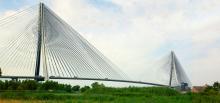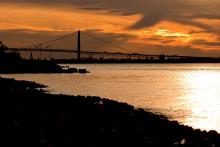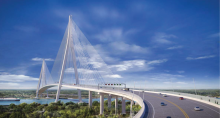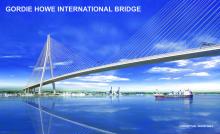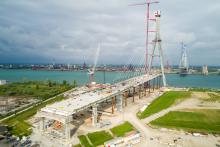A devaluing Canadian dollar has pushed up the cost for building a signature Windsor-Detroit bridge by around US$2.5 billion, according to Canadian media reports.
The increase more than doubles what was believed needed by the Canadian government to construct the Gordie Howe Bridge, named after a Canadian ice hockey player who played most of his career for the Detroit Red Wings.
The toll bridge, to be built under a public private partnership, will link the US city of Detroit, in the state of Michigan, w
A devaluing Canadian dollar has pushed up the cost for building a signature Windsor-Detroit bridge by around US$2.5 billion, according to Canadian media reports.
The increase more than doubles what was believed needed by the Canadian government to construct the Gordie Howe Bridge, named after a Canadian ice hockey player who played most of his career for the Detroit Red Wings.
The toll bridge, to be built under a public private partnership, will link the US city of Detroit, in the state of Michigan, with the Canadian city of Windsor in the province of Ontario.
Although the bridge is economically important to the United State and Canada, it will be a totally Canadian project. Around a quarter of the annual $658 billion Canada-US trade crosses over the river. The vast majority of cross border commercial traffic now uses the 2.3km US privately owned Ambassador Bridge, whose owners have tried to stop the construction of a new bridge.
Canada is also paying an estimated $1.77 million for a US customs plaza on the American side, as well as access roads linking US freeways to the bridge.
In January last year the Windsor-Detroit Bridge Authority, set up to manage building a new bridge, appointed the Canadian arm of California-based3220 Parsons as general engineering consultant under a reportedly $17 million contract. At the time of the appointment, the value of the Canadian dollar to the US dollar was CAN$1.21. The value now in January is around CAN$1.40.
This month, the news agency Canadian Press reported that Canadian Prime Minister Justin Trudeau was recently warned in secret briefing documents that cost increases were likely. The agency also reported that the Canadian government can expect to collect around $2.84 in tolls over 30 years that would cover the cost increases as calculated by consultants5299 Deloitte in October.
If all goes well, a new bridge should be open by 2020, although its design is not finalised. Gordie Howe, now 87, is a Canadian ice hockey player who joined the Detroit Red Wings of the National Hockey League in 1946 and over the next 25 years helped the team win four league championships.
The bridge is not without controversy, as %$Linker:2 Internal <?xml version="1.0" encoding="utf-16"?><dictionary /> 2 22229 0 oLinkExternal reported Reported by World Highways false /sections/key-projects/features/new-international-trade-crossing-linking-canada-and-us/ false false %> by World Highways last year.
A Transport Canada notice in 2008 suggested two designs. A suspension bridge would have an elongated ‘M’ shape, similar to the Ambassador Bridge. A cable-stayed structure would be noticeable by its ‘A’ shape, similar to the Sunshine Skyway Bridge in Tampa, Florida. Both options would be nearly 3km long.
The suspension option would have 855m spans while a cable-stayed bridge would use 840m spans. Both bridges would have the same 40m clearance at the shorelines and have a 47m clearance at channel centre.
Main towers for the cable-stayed option would be 250m high main towers while a suspension bridge’s towers would be around 140m. Both options would have 36m wide decks for six lanes and include a median, shoulders and – security concerns aside - a walkway and/or cycle path on one side.
A Canadian customs plaza might cover around 43 hectares with 29 inbound inspection lanes, including nine for cars, 14 for trucks and five for both cars and trucks. One lane would be for buses.
The increase more than doubles what was believed needed by the Canadian government to construct the Gordie Howe Bridge, named after a Canadian ice hockey player who played most of his career for the Detroit Red Wings.
The toll bridge, to be built under a public private partnership, will link the US city of Detroit, in the state of Michigan, with the Canadian city of Windsor in the province of Ontario.
Although the bridge is economically important to the United State and Canada, it will be a totally Canadian project. Around a quarter of the annual $658 billion Canada-US trade crosses over the river. The vast majority of cross border commercial traffic now uses the 2.3km US privately owned Ambassador Bridge, whose owners have tried to stop the construction of a new bridge.
Canada is also paying an estimated $1.77 million for a US customs plaza on the American side, as well as access roads linking US freeways to the bridge.
In January last year the Windsor-Detroit Bridge Authority, set up to manage building a new bridge, appointed the Canadian arm of California-based
This month, the news agency Canadian Press reported that Canadian Prime Minister Justin Trudeau was recently warned in secret briefing documents that cost increases were likely. The agency also reported that the Canadian government can expect to collect around $2.84 in tolls over 30 years that would cover the cost increases as calculated by consultants
If all goes well, a new bridge should be open by 2020, although its design is not finalised. Gordie Howe, now 87, is a Canadian ice hockey player who joined the Detroit Red Wings of the National Hockey League in 1946 and over the next 25 years helped the team win four league championships.
The bridge is not without controversy, as %$Linker:
A Transport Canada notice in 2008 suggested two designs. A suspension bridge would have an elongated ‘M’ shape, similar to the Ambassador Bridge. A cable-stayed structure would be noticeable by its ‘A’ shape, similar to the Sunshine Skyway Bridge in Tampa, Florida. Both options would be nearly 3km long.
The suspension option would have 855m spans while a cable-stayed bridge would use 840m spans. Both bridges would have the same 40m clearance at the shorelines and have a 47m clearance at channel centre.
Main towers for the cable-stayed option would be 250m high main towers while a suspension bridge’s towers would be around 140m. Both options would have 36m wide decks for six lanes and include a median, shoulders and – security concerns aside - a walkway and/or cycle path on one side.
A Canadian customs plaza might cover around 43 hectares with 29 inbound inspection lanes, including nine for cars, 14 for trucks and five for both cars and trucks. One lane would be for buses.

